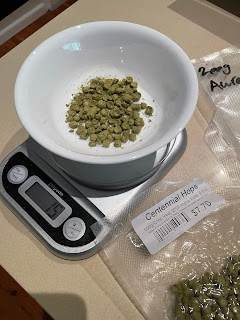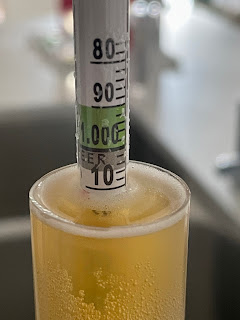
Here's a rundown on our latest BrewZilla brew day, using our 35L BrewZilla 3.1.1 and Digiboil 35L sparge water heater.
This brew day was bringing to life our Best American Pale Ale Recipe.
 |
| All our ingredients ready for brew day |
Without going into the full recipe (check out the link above), we've got a mixture of pale, pilsner, carapils and melanoidin malt. We ended up going with the Gladfield equivalent of the last two malts (Gladiator for carapils and Aurora for melanoidin), as that's what our local home brew supply store had available. For the hops we're going with Centennial and Amarillo as they're a well known and timeless/classic combination for an American Pale Ale.
For the yeast we're using Mangrove Jacks M36 Liberty Bell dry yeast - this is our first batch using any variety of Mangrove Jacks yeast so we're excited to see how it goes.
Mashing in and the mash itself went to plan and was largely uneventful. After adding the grain, we gave it a thorough stir, then left the grain bed to settle for 10 minutes before turning on the pump to recirculate the wort. Once we switched on the pump we started our 60 minute timer for the mash.
The mash itself was quite thick, so we didn't get a particularly good flow when recirculating and had to restrict the pump flow quite a lot. It never really 'backed up' or got stuck though which is good. We also stopped the pump and stirred the grain bed 3 times during the mash (every 15-20 minutes).
We always use the BrewFather app to calculate our water chemistry and strike/sparge water volumes and it's never failed us. The built in profile for the 35L BrewZilla is great and really accurate in our experience.
At the end of our 60 minute mash we raised the temperature to 75c for the mash out step. Ramp up time was pretty decent at around 5 minutes or so (using both heating elements). We calculate grain bed temperatures using a long probe thermometer in the top of the grain bed for more accurate temperature measurement rather than relying on the temperature reading on the display of the BrewZilla.
 |
| Our long probe thermometer fits well through the lid to measure the grain bed temperature from the top |
We've found after a bit more practice we're getting better at dialling in and maintaining our mash temperature. Setting the BrewZilla to around 5c above the target temperature seems to be the sweet spot, which seems like a lot but it works well for us.
Sparging also went without a hitch - we suspect that the combination of a proper mash out to raise the temperature to 75c and sparging with water heated to the same temperature really helps the sparge water flow back through the grain bed. Sparging took next to no time at all and the water was flowing through faster than we could pour it in using a 1L jug.
Pre-boil gravity sample taken and it was surprisingly higher than expected at 1.052 (recipe expected 1.046)
 |
| Pre-Boil Gravity Reading - 1.052 - several points higher than expected |
We went with a classic 60 minute boil as that's what the original recipe (sourced from David Heath's YouTube channel) calls for. There are quite a few hop additions so we measured all these out whilst waiting for boil temperature to be reached. Planning and organisation is key on brew day!
 |
| Measuring out hop additions whilst waiting for the boil |
Boil was promptly reached and hop additions added at 60, 10, 5 and then again at flameout as per the recipe.
 |
| The Boil |
At the end of the boil, we had a reasonable hop addition/hop stand to be added when the wort temperature is dropped to 80c then held for 15 minutes - also known as a whirlpool addition.
This was only our second attempt at a hop stand so we adjusted our method slightly based on the lessons learnt last time we attempted. After starting the initial cooling process with the immersion chiller, we waited for the temperature to drop to around 85c before stopping the water flow through the chiller. The drop from boil to 85c was very quick, probably less than 90 seconds. During which time we adjusted the set temperature of the BrewZilla to 85c and left both heating elements on.
We had the whirlpool arm installed as well so switched the pump on to begin recirculating the wort through the whirlpool arm. The end result of all this was a rock solid 80-82c temperature throughout the entire hopstand which we were very happy with.
 |
| Whirlpool/hop stand temperature at ~80c |
After our 15 minute hop stand, we began flowing water through the immersion chiller again to finalise the chilling down to around 24c then transferred to our FermZilla fermenter using the pump and recirculation arm.
After transporting the wort home and into our fermenting fridge, we pitched the yeast and set the target temp to 20c.
Our Original Gravity was also higher than expected at 1.055-1.056 (recipe expected 1.051) which is great and means that our efficiency is improving. These numbers give us a brewhouse efficiency of 82% which is awesome.
 |
| OG Gravity Reading 1.055 but a more realistic 1.056 with temperature correction |
Pleasingly, fermentation was underway the next morning and is tracking well. This is also our first fermenting using our new Rapt Pill hydrometer/thermometer so it's been great having a more accurate insight into the fermentation that we didn't previously have.
Surprisingly, the fermentation seemed really fast for this beer. After pitching yeast on Saturday afternoon, by Sunday mid-morning, fermentation was underway (we started to see gravity movements from our RAPT Pill), and final gravity of 1.010 was reached 72 hours later on Tuesday morning at around the same time. This was our first fermentation with this kind of visibility, but it does seem pretty fast!
We'll definitely be leaving it for at least another week before transferring to our keg in order to give the yeast ample time to clean up any by products like diacetyl and let the flavours mellow/settle.
 |
| Fermentation graph from the Rapt Pill |
After 7 days in the fermenter we took a "regular" hydrometer reading and found the result pretty consistent with what our Rapt Pill was saying (1.010)
Initial tasting was very promising, still a little astringent or 'green' with alot of grainy flavours but this will no doubt start to clear up over the next week
Check out the Tasting & Review of our Best American Pale Ale





























